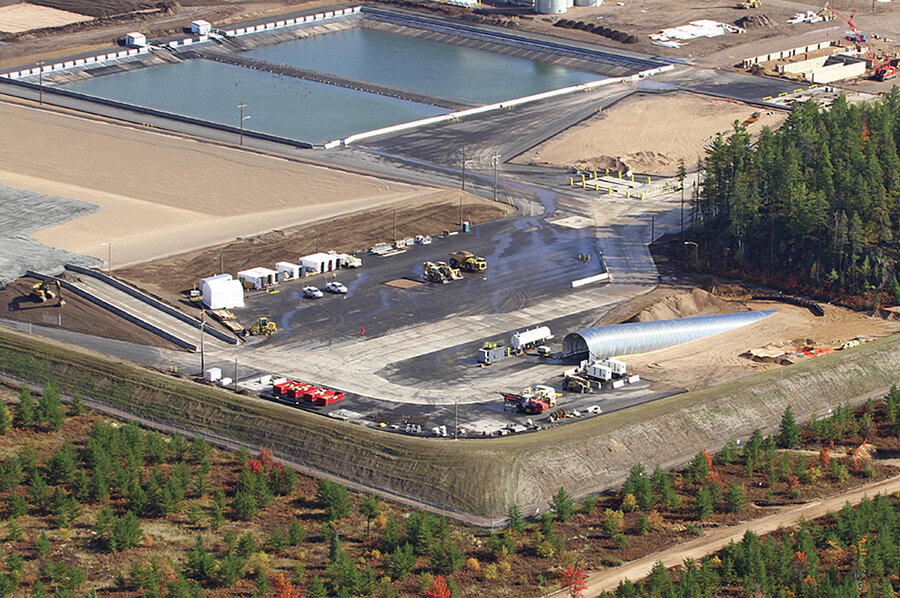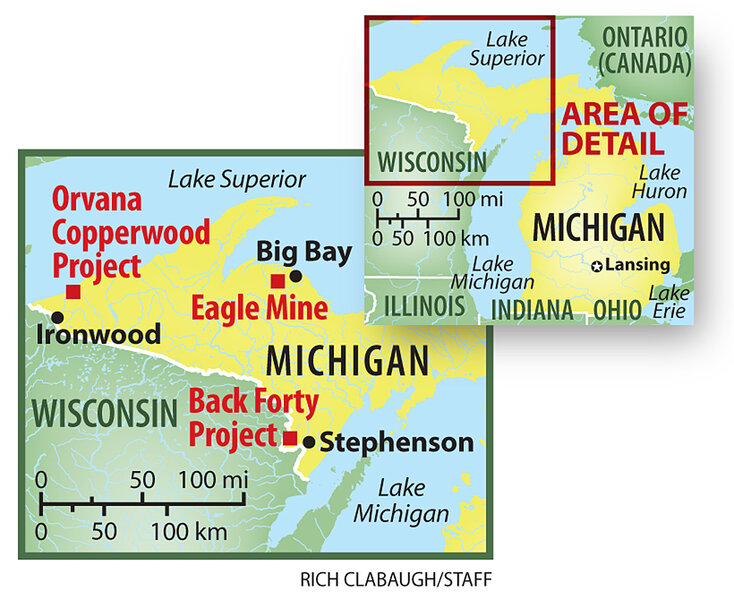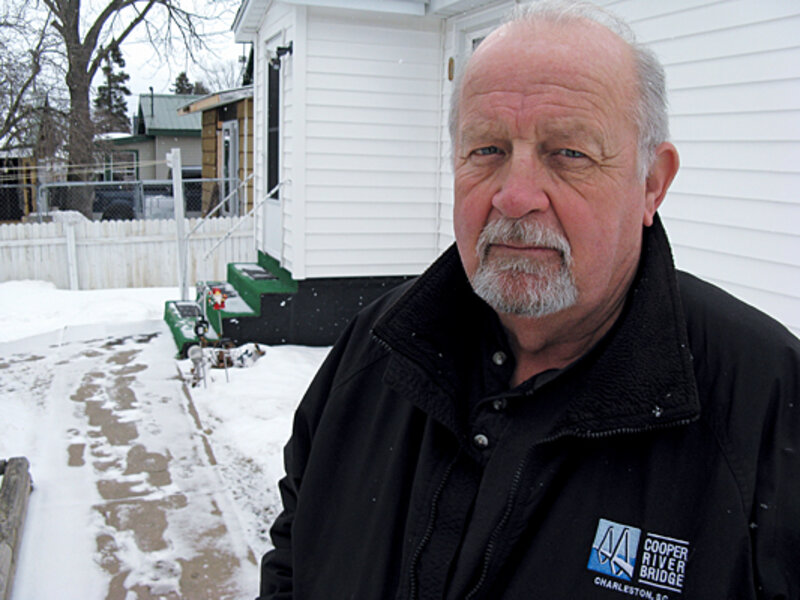Mining boom in Michigan: economic boost or environmental nuisance?
Loading...
| Big Bay, Mich.
Jeff TenEyck was glad to come home last year. He had left Michigan for a small trucking business in South Carolina but returned to work at a new mine just outside Big Bay, the little mill town where he grew up.
"This is the biggest shot in the arm for the economy here since Henry Ford was here," says Mr. TenEyck, whose grandfather worked in a lumber mill that Ford bought in 1943.
Driven by a worldwide surge in demand for metals, mining is on the rebound in Michigan's Upper Peninsula, bringing the hope of jobs to remote and economically depressed rural communities. A dozen miles south of Big Bay, London-based mining giant Rio Tinto PLC and its subsidiary, Kennecott Eagle Minerals Co., are digging a shaft beneath a pine-covered flat called the Yellow Dog Plains. They plan to begin extracting nickel and copper early next year. Rio Tinto says the Eagle Mine will be the largest nickel mine in the country and will create as many as 700 new jobs.
Meanwhile, Orvana Minerals Corp., a Canadian mining company based in Toronto, is close to final approval for a copper mine expected to create hundreds of jobs in the sparsely populated western Upper Peninsula. Next in line, Aquila Resources Inc. and HudBay Minerals Inc. plan to apply for a permit later this year to mine zinc, gold, and silver at a small, open-pit mine along the Menominee River called the Back Forty Project.
There could be more. Mining companies have been busy prospecting for new deposits, crisscrossing the Upper Peninsula by plane and helicopter, drilling exploratory holes, leasing land, and buying up mineral rights. They've revisited old mines to see if new technology might make it profitable to reopen them.
"It's like flies to honey," says Theodore Bornhorst, professor of economic and engineering geology at Michigan Technological University in Houghton. "It's got a lot of people interested."
The prospect of jobs has also excited the hopes of residents. "It's a no-brainer for most people," says Amy Clickner, head of the Lake Superior Community Partnership, an economic development corporation in Marquette, Mich. "We do have a culture used to mining here. And the people who live up here do have to have jobs."
At the same time, many residents worry that new mining could damage the environment and threaten the natural abundance that they enjoy as hunters and anglers.
Around Big Bay, opponents of the Eagle Mine, including a local group of Ojibwa Indians, have packed hearings, gotten themselves arrested, and traveled to London to speak out at meetings of Rio Tinto shareholders. They have sued Michigan's Department of Environmental Quality for granting a mining permit in 2007. Most recently, they have been fighting the construction of a haul road through a wild area south of the mine.
"Of course we want jobs back in Baraga County," says Susan LaFernier, tribal council secretary for the Keweenaw Bay Indian Community, which lies west of the mine in a county with 18 percent unemployment. "We'd be crazy if we didn't. But we think the harm isn't worth those jobs."
The revival of mining in Michigan is driven by rising demand for metals on the world market, especially in developing countries like India and China. Michigan's neighbors, including Wisconsin and Minnesota, and Western states like Arizona and Utah have also seen increased mining.
"Everyone's hiring like crazy," says Carol Raulston, a spokeswoman for the National Mining Association.
Mining has long been a part of the local economy in Michigan. Native Americans excavated copper from surface de-posits around Lake Superior and traded it as far as the Gulf Coast and the Rocky Mountains. Large-scale mines opened in the 1800s. But the heyday of mining soon passed; today just two open-pit iron ore mines survive in the Upper Peninsula.
Some communities, especially small cities like Houghton and Marquette, have diversified their economies and no longer depend on only one or two industries. Others, like Ironwood, a town of 5,494 in the western Upper Peninsula, have never recovered from mining's collapse.
James Oliver, a Gogebic County commissioner, says the town's population has fallen by two-thirds since the copper mines closed, and it's still shrinking. At a hearing in March, most of the nearly 400 people who showed up supported the new Orvana copper mine.
"It means a lot of jobs for us in the area, trickling down from the mine," says Mr. Oliver.
Still, the need for jobs has not eclipsed worries about mining and the environment. This conflict was thrown into sharp relief in March in northern Wisconsin, where mining company Gogebic Taconite proposed a $1.5 billion open-pit iron mine in the Penokee Hills near Mellon – but only if Wisconsin streamlined its application procedure. On March 6, the Wisconsin State Senate narrowly rejected a new mining law, whereupon Gogebic Taconite announced it was giving up.
"We're heartbroken," says Joseph Barabe, Mellon's mayor and the grandson and great-grandson of miners. "We wanted the mine." But the new law would have offered too little protection for local water and too few financial guarantees for communities, he adds. "We would get all these jobs, but it would bankrupt the town."
Mr. Bornhorst, who directs the A.E. Seaman Mineral Museum in Houghton, says mining's environmental record is much improved. Stricter regulations, he says, have reduced its risks. "I think all mining companies are put on notice that they have to be as responsible as they can be," he says.
At the Kennecott Eagle Mine near Big Bay, mine operators are collecting runoff in lagoons and treating it to prevent acidified and metal-laden water from trickling into streams. Mine waste will be stored and put back in the mine when the mining is finished.
But around Big Bay, many residents aren't satisfied. They say officials have been too eager to please mining officials and that state regulations are lax.
"I'm not against mining," says Chauncey Moran, an activist who has been testing water near the Kennecott mine and taking regular flights over the site to watch for problems. "It's the health of the water and the health of the community that really matter."
Many also question the real potential for new mining jobs. Rio Tinto has pledged to give 75 percent of the jobs to local residents. But skeptics believe the jobs will be too few and shortlived to have much lasting economic benefit.
Even Jeff TenEyck wonders. He'd like his 26-year-old son to move back to Big Bay, too. But despite the new mine, he laments, "there's no work."









